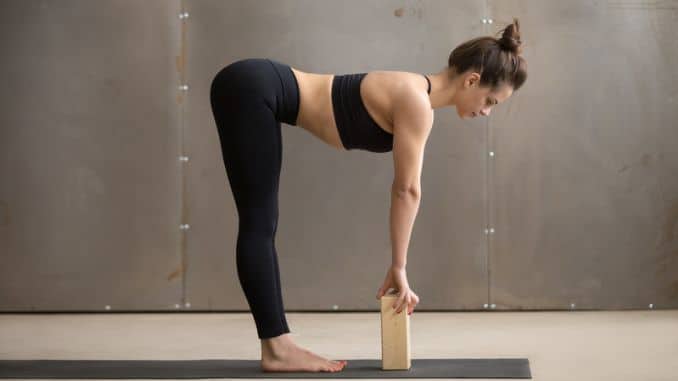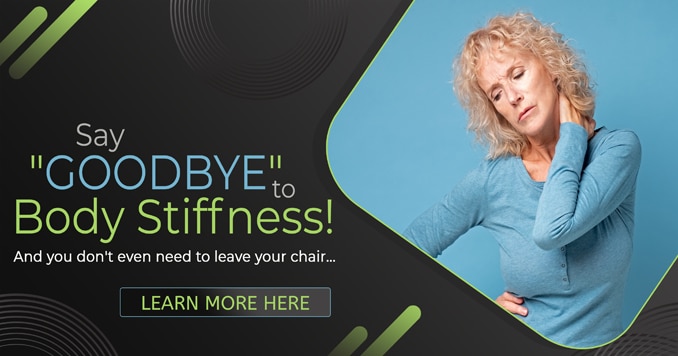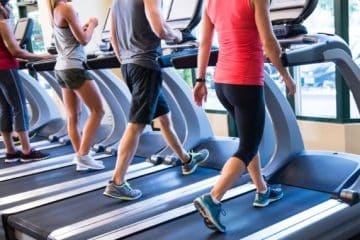Whether you’re new to yoga or looking to deepen your practice, these simple yet effective yoga block poses will help you build flexibility, increase mobility, and release tension.
By incorporating yoga blocks into your routine or yoga class, you’ll find added support and stability, allowing you to explore the new depths of each stretch safely. Introducing 15-minute yoga block poses that we've designed to help you achieve balance in your life. Get ready to transform your body and mind in a short span of time!
Importance of Building Flexibility in Yoga Practice
Building flexibility in your yoga practice is essential for maintaining a healthy body. Flexibility is the ability to move joints and muscles through their full range of motion.
The following are the benefits of building flexibility in your practice:
- It can develop whole-body strength.
- It improves posture and helps achieve proper alignment.
- It prevents injury.
- It maintains joint health.
- It enhances body awareness and balance.
- It releases tension and stress. It helps achieve calmness.
Whether you’re a seasoned yogi or just starting out, incorporating flexibility-building postures into your practice can help you achieve your fitness goals.
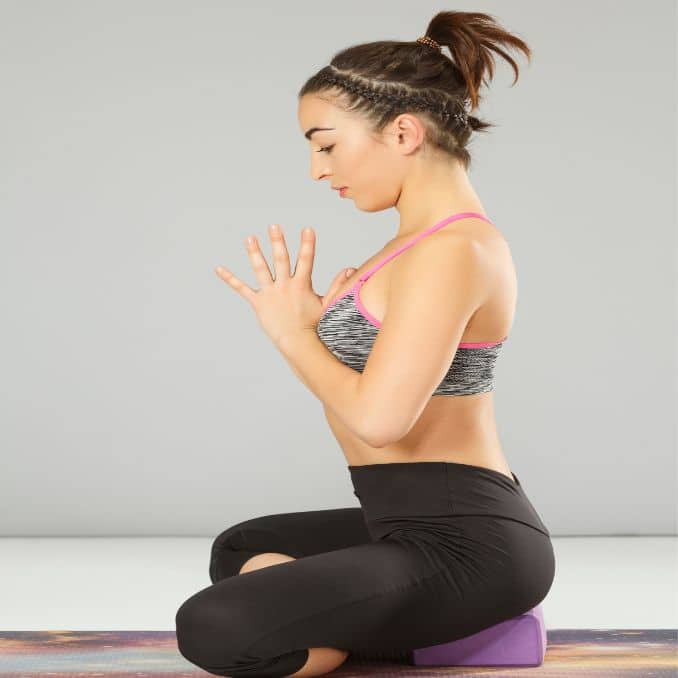
Benefits of Using Yoga Blocks for Beginners
Many yoga practitioners use yoga blocks to improve their poses which would otherwise be difficult to do due to flexibility or strength limitations.
Use yoga blocks to help you achieve the following benefits:
1. Provides Support and Flexibility
One of the primary reasons to use yoga blocks is that they provide support and flexibility in yoga block poses. These blocks are designed to provide stability in different poses, allowing practitioners to hold poses for longer periods.
A yoga block helps practitioners achieve a deeper stretch and reach new levels of flexibility.
2. Helps Achieve Proper Alignment
With the use of yoga blocks, you can maintain proper alignment and improve posture. Many yoga poses require a certain amount of flexibility, and if you lack that flexibility, you may struggle to achieve correct alignment in a pose.
3. Allows for Deeper Stretches and Poses
Use yoga blocks to deepen your stretches. Many yoga postures require deep stretching of the muscles. If you’re not flexible enough to achieve a deep stretch on your own, using a yoga block can help you.
It’s extremely beneficial for your practice to use yoga blocks in your yoga block poses. Start with one block and gradually add more as you become comfortable with them.
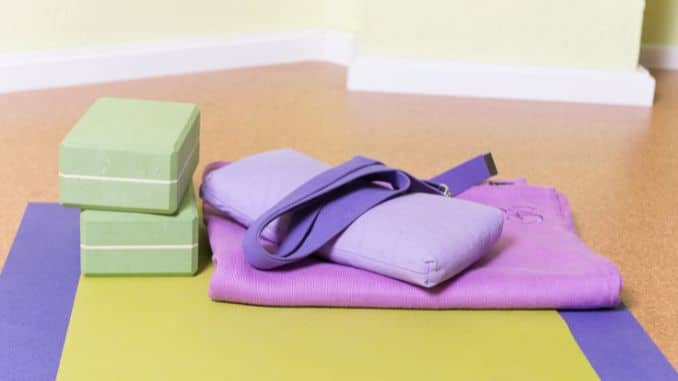
Types of Yoga Block
Some yoga poses are challenging, especially for beginners. This is where yoga blocks come in handy. Yoga blocks are rectangular props made from foam, cork, or wood that help practitioners attain needed support.
Yoga blocks are made of different materials and come in various shapes and sizes. Below are the common types of yoga blocks for all level practitioners.
Yoga Block Materials, Sizes, & Shapes
With so many options available on the market, you’re sure to find a yoga block that suits your style and preferences.
A. Cork
Cork blocks are more durable and sturdy than foam blocks, making them ideal for advanced practitioners who need more stability while practicing challenging poses. They’re made of natural cork material that provides excellent grip and support for different yoga postures.
Cork blocks come in different sizes, such as 3-inch, 4-inch, or 5-inch heights, which can be used based on individual preferences and needs.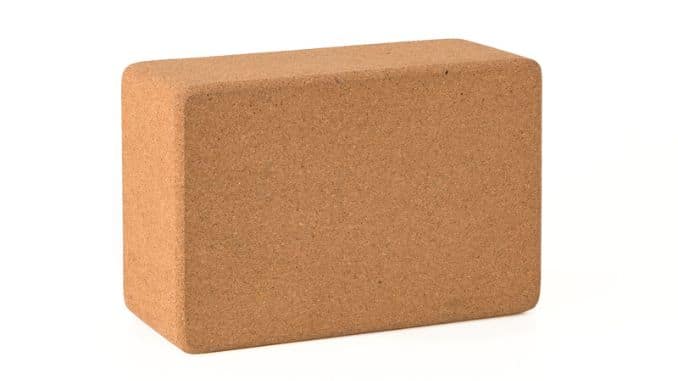
B. Foam
Foam blocks are the most commonly used type of yoga block because they are lightweight and easy to use. They’re made of soft foam material that provides a comfortable grip and support for various yoga postures.
Foam blocks come in different sizes, such as 3-inch, 4-inch, or 5-inch heights. A foam block is perfect for beginners who need extra support while performing certain yoga postures.
 C. Wooden
C. Wooden
Wooden blocks are among the most popular types of yoga blocks due to their durability and eco-friendliness. Some of the common materials used for wooden blocks are bamboo, birch, maple, and oak.
A yoga block made of bamboo is ideal for those who want to reduce their carbon footprint. Birch and maple are more durable than bamboo and can withstand heavy usage without getting damaged.
The standard size for a yoga block is around 9 inches by 6 inches by 4 inches. This size works well for most people, depending on their body size and flexibility. Some manufacturers offer blocks that are 3 inches high or up to 12 inches long, while others offer mini-blocks that are just 3 inches by 6 inches.

Consider the material, size, and shape to ensure that your chosen yoga block helps you achieve your yoga goals and meets your needs.
How to Choose the Right Yoga Block
Choosing the right yoga block helps achieve a deeper stretch. Here are some factors to consider when selecting a yoga block:
A. Material
Consider the material that feels comfortable and aligns with your preferences.
The ideal yoga blocks for beginners are foam blocks, as they offer comfort and support without being too hard or heavy. A softer surface for support is best since beginners are still working on their flexibility and balance. So make sure to choose one that is firm enough to provide support but not too hard that it causes discomfort during yoga block poses.
B. Size
Consider your body proportions, height, length of your arms, and flexibility level when choosing the size of your yoga block. The standard size is 9x6x4 inches, but taller individuals or those with limited flexibility may benefit from a taller block.
C. Shape
Some brands offer circular or curved yoga blocks. The shape you choose depends on the type of practice you follow. Rectangular blocks provide stable support for standing postures, while circular or curved blocks offer more versatility for restorative poses.
There are also wooden blocks that are circular, square, or even heart-shaped, which adds fun and creativity to your practice.
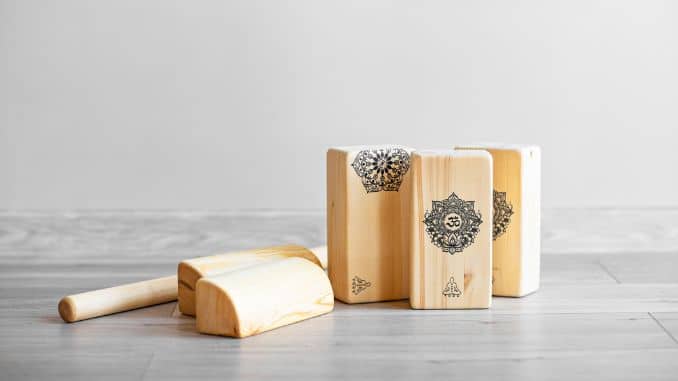
D. Weight
If you’re always on the go and frequently bring your yoga block with you, consider the weight. Foam yoga blocks are lighter, making them more portable, while wood and cork blocks tend to be heavier.
Remember that the right yoga block can make a significant difference in your practice, so invest in one that suits your needs. Taking these factors into account will help you choose a yoga block that enhances your practice and supports your yoga journey, including various yoga block poses.
Yoga Block Poses for Beginners to Build Flexibility
Incorporating blocks into your practice as a beginner builds flexibility.
1. Mountain Pose
Start your practice with Mountain Pose (Tadasana) to help you establish a solid foundation.
For this exercise, stand by the wall, a chair, or a sturdy baluster for stability.
Begin in an upright standing position with your feet hip-width apart Maintain good alignment with your head, shoulders, hips, and legs. Engage your core and place your hands either on the sides of the backrest of a chair. Pay attention to your triangle base of support as you ground your toes and heels firmly on the floor. Hold the position for several deep belly breaths, in through your nose and out through your mouth.
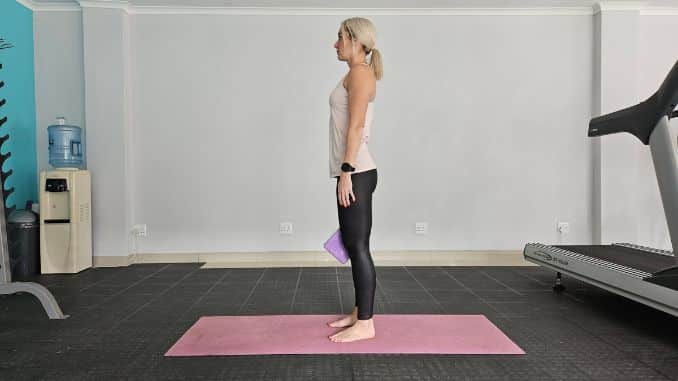
Mountain Pose
2. Chair Pose
Another great yoga posture for beginners who want to build flexibility in their legs, hips, and back is Chair Pose (Utkatasana). Using a yoga block helps maintain proper form and prevent knee or hip injuries.
For this exercise, stand by the wall or a chair for support.
Begin in an upright standing position, facing the back of a chair, arm-length away, with your feet hip-width apart. Maintain good alignment with your head, shoulders, hips, and legs. Place and squeeze a yoga block between your knees or thighs, ensuring it won’t fall. Extend your arms at chest height or hold on to the chair's backrest for stability. Contract your abdominal muscles, then slightly bend through your hips and knees to move into a squat position, like sitting on a chair. Hold this position for 3 deep belly breaths. Relax and slowly return to the starting position.
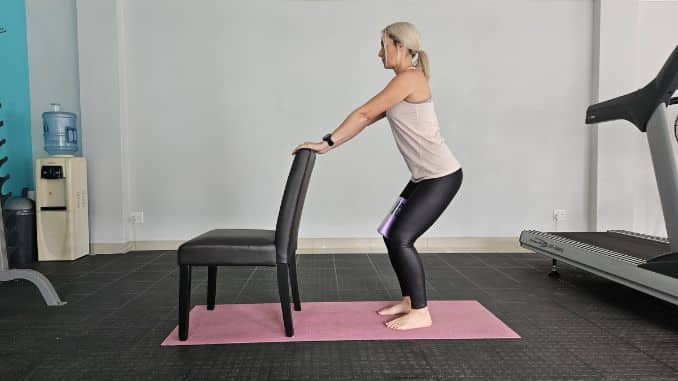
Chair Pose
3. Lunge Pose
This is an excellent pose for beginners who are new to yoga and are looking to strengthen their muscles. This can be done with or without a yoga block, but using one helps achieve greater flexibility. To do the Lunge pose with a yoga block:
Stand by the wall or a chair for support.
Begin in an upright standing position, facing the back of a chair, arm-length away, with your feet hip-width apart. Maintain good alignment with your head, shoulders, hips, and legs. Hold a yoga block with both hands and place it on the backrest of the chair for support. Slightly bend your knees, then take a big step back with one foot, keeping your front knee bent and all your toes pointing forward. Tighten your abdominal area and shift your hips forward. Hold this position for a few seconds. Relax and repeat the movement on the opposite side. Then move onto the Lunge with Arm Bend pose.
You can slightly bend your back knee while holding the position for comfort.
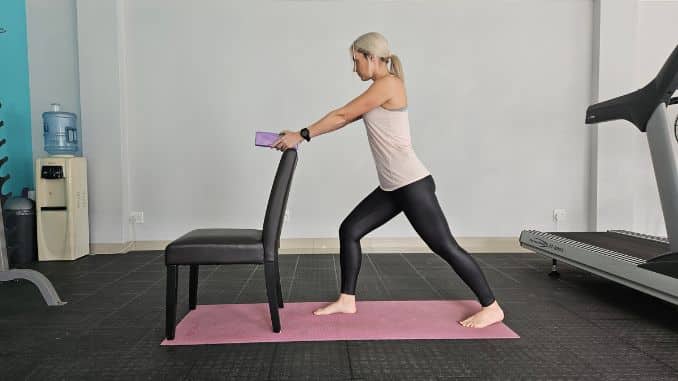
Lunge Pose
4. Lunge with Arms Bend
A recommended yoga block pose for beginners is the Lunge with Arm Bend. This effective exercise helps stretch the hips and hamstrings.
Begin in an upright standing position with your feet hip-width apart. Maintain good alignment with your head, shoulders, hips, and legs. Hold a yoga block with both hands and place it on the backrest of the chair for support. Engage your abdominal muscles and slightly bend your knees, then take a big step back with one foot, keeping your front knee bent and all your toes pointing forward. Shift your hips forward and inhale as you raise both arms overhead, squeezing the yoga block with both palms. Then, exhale as you bring your hands behind your head, bending both elbows. Repeat the movement with 5 repetitions. Relax, return to the starting position, and repeat the movement on the opposite side.
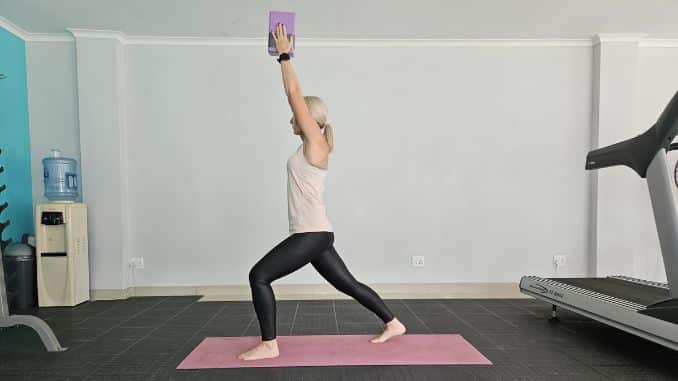 |
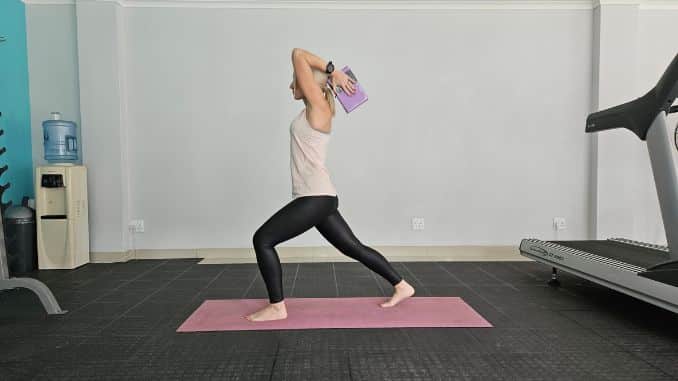 |
Lunge with Arm Bend
5. Triangle Pose (Utthita Trikonasana)
The Triangle Pose is a popular yoga pose that offers many benefits. In addition to building flexibility, strength, and balance, Triangle Pose can also help improve digestion, relieve stress, and stimulate the abdominal organs.
Use yoga blocks in Triangle Pose to provide support and stability, making it easier to achieve proper alignment and deepen the stretch.
Stand by the wall or a chair for support. You can use a yoga mat for more stability.
Begin in an upright standing position with your feet hip-width apart. Maintain good alignment with your head, shoulders, hips, and legs. Take a big step back with one leg and pivot your back foot so that your toes are pointing out to the side and your front heel is pointing to the arch of your back foot. Keep your front knee bent, your foot grounded on the floor, your toes pointing forward, and hinge through your hips to bend your upper body forward, place your hand on top of the yoga block for support. Contract your core, press your weight onto the yoga block with one hand, and reach upward with your opposite arm, opening the front of your body. Head in line with your spine, hold the position for several deep breaths, then return to the starting position. Repeat the sequence of movements on the opposite side.

Triangle Pose (Utthita Trikonasana)
Tips for Beginners on Using a Yoga Block
Yoga blocks are versatile props that can help build confidence in various poses.
As a beginner, use yoga blocks to enhance your practice. They can provide support in various standing poses, sitting, and supine positions.
Here are a few tips to make the most of your yoga block.
Start with Basic Poses
It’s important to start with basic poses and gradually move towards more advanced poses. Remember that using a yoga block is not a sign of weakness but rather a tool to aid in achieving correct alignment and preventing injury. As one progresses in their practice, they can gradually reduce the use of blocks and move towards more challenging poses.
Below are 10 basic yoga block poses for beginners.
1. Downward Facing Dog
Position two yoga blocks underneath your hands to elevate the ground and make Downward Facing Dog more accessible, relieving pressure on the wrists. Downward Facing Dog prepares the body for modified or intermediate poses.
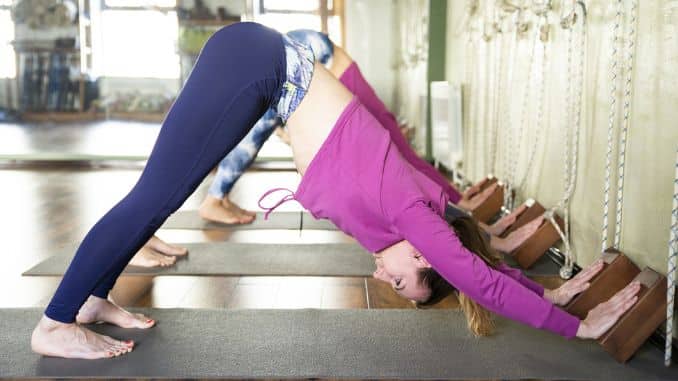
2. Child’s Pose
Place a block underneath your head and rest on it while keeping your knees wide, providing support and relaxation to your Child’s Pose.
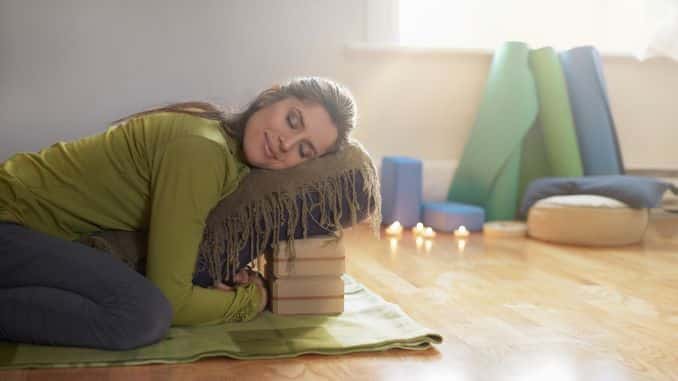
3. Fish Pose Variation
Incorporating a block into a Fish Pose provides additional support. Placing a block underneath your upper back supports your spine as you recline in a traditional Fish Pose.
A Supported Fish Pose, on the other hand, helps alleviate tension in the upper body and improve posture. For individuals with limited flexibility or those seeking a restorative practice, a Supported Fish Pose is especially recommended.
To suit your comfort level, use yoga blocks so you can adjust the height and intensity of the backbend. A yoga block in the Supported Fish Pose variation adds stability and allows you to experience the benefits of this heart-opening posture better.
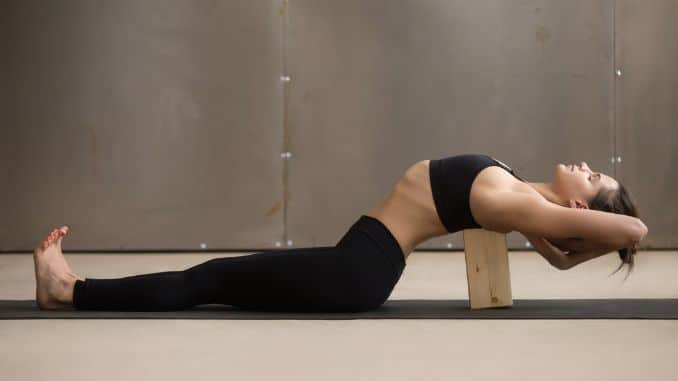
4. Extended Crescent Lunge
By placing a block underneath the hand, beginners can experience improved stability and a deeper stretch in this energizing pose.
5. Low Lunge
Place a block under your front hand for balance while performing a Low Lunge, ensuring good alignment and support.
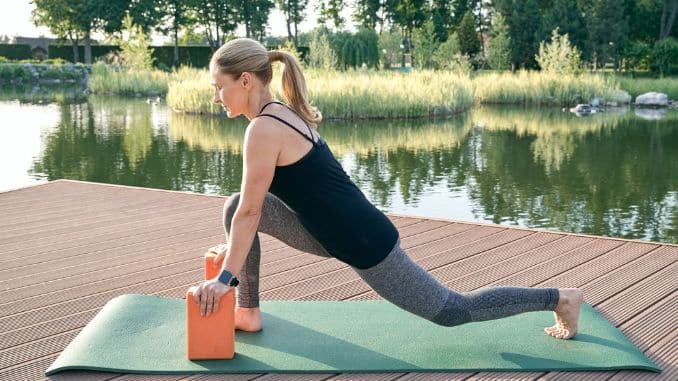
6. Forward Fold Variation
This pose can be modified with the use of a block. A block helps beginners work towards touching the floor in a traditional Forward Fold.
Another is a Seated Forward Fold. Sit on a block to elevate your hips, or place a block under your forehead to make it easier to fold forward in Seated Forward Fold.
While on the Wide-Legged Standing Forward Fold, place a block under the hands for better enhancement. Standing Forward Fold is a calming and rejuvenating posture that deepens the stretch in the hamstrings and lower back.
Explore the Forward Fold variations with confidence, using a yoga block to gradually work towards greater flexibility.
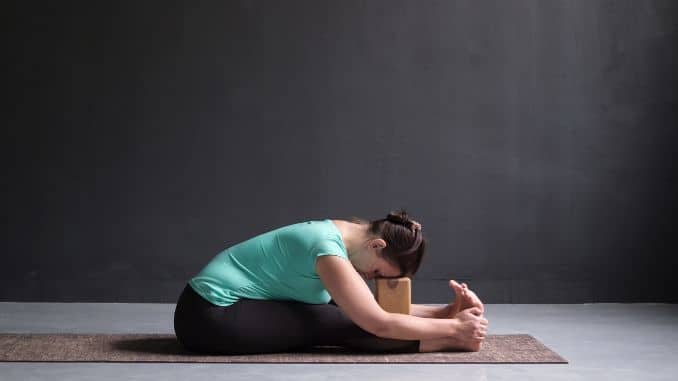
7. Puppy Pose
A Puppy pose (Heart Melting Pose) is a gentle, heart-opening pose that can be enhanced with the use of a block. By resting the forearms on a block, beginners can find support and relaxation while stretching the shoulders, chest, and spine.
8. Reclined Bound Angle
Place a block underneath each knee to support the legs in Bound Angle Pose, allowing for a comfortable and supported stretch in the hips and inner thighs. Reclined Bound Angle Pose (Supta Baddha Konasana) is a soothing and restorative pose that promotes relaxation.

9. Supine Spinal Twist
A beginner-friendly pose, the Supine Spinal Twist, can be enhanced with the use of a block. Place a block under the head or bent knee to enjoy a gentle twist that releases tension in the spine.
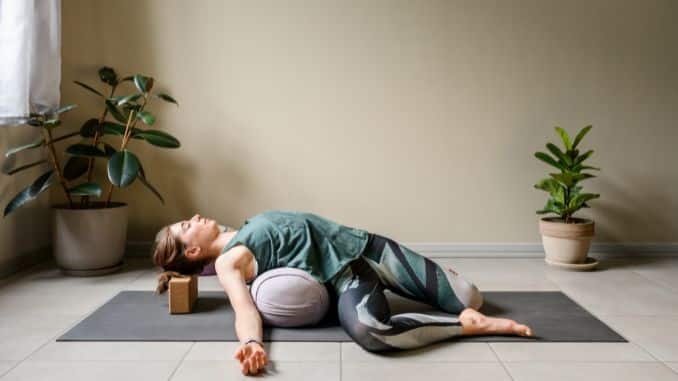
10. Bridge Pose (Setu Bandha Sarvangasana/Dvi Pada Pithasana)
Incorporating a yoga block in this pose allows beginners to experience the benefits of Bridge Pose with increased relaxation, fostering strength and flexibility. Place a block horizontally or vertically under your sacrum for support while lifting your hips off the ground in Bridge Pose for a solid foundation.
You can also try Supported Bridge Pose. Position a block vertically between your thighs and squeeze it as you lift your hips into Supported Bridge Pose. This Supported Bridge Pose activates your inner thighs and glutes, creating a gentle backbend.
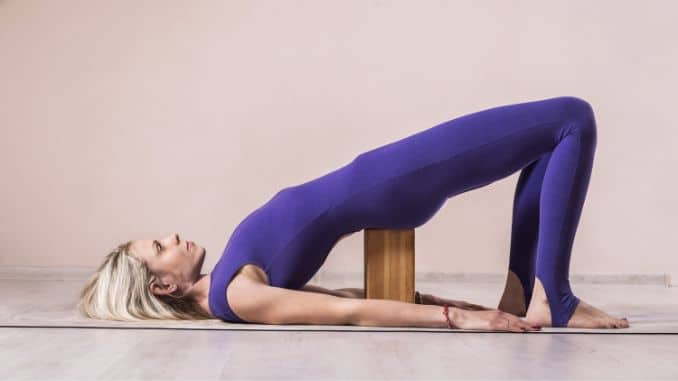
Remember to listen to your body and modify a yoga pose as needed.
Gradually Work Your Way Up
A yoga block is a great way for beginners to work their way up to more challenging poses. By gradually increasing the difficulty level, you can build strength, flexibility, and confidence in your practice.
Check out the list below for suggested intermediate and advanced yoga poses with blocks.
A. Intermediate Yoga Poses
1. Standing Half-Moon Pose
The Standing Half Moon Pose can be further amplified with a block. To practice this, place a block on the floor at its tallest height to support your bottom hand while balancing in Half Moon Pose. Hold longer and allow a greater stretch in Half Moon Pose with a yoga block.

2. Extended Side Angle Pose
Hold a block with both hands and place it on the inside of your front foot to provide support in Extended Side Angle Pose. Explore other Extended Side Angle variations for a deeper side stretch.
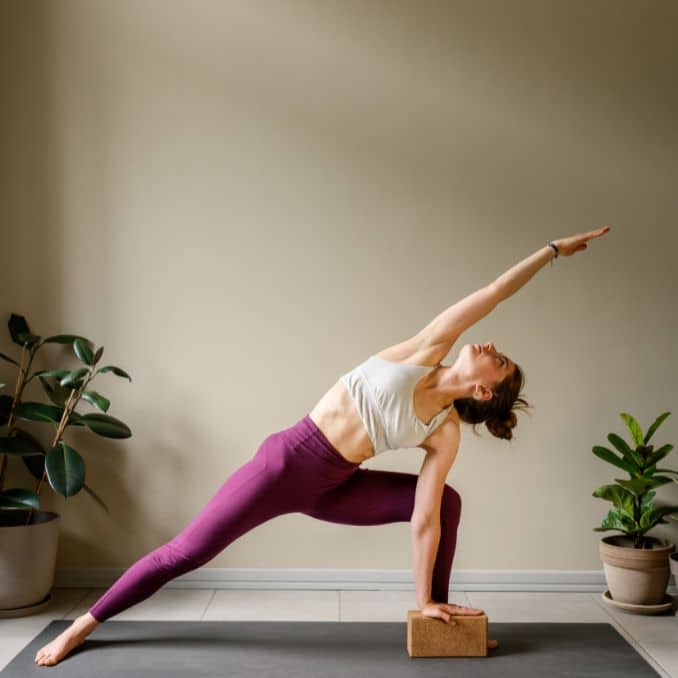
3. Revolved Side Angle Pose
In Revolved Side Angle Pose, place a block on the inside of your front foot to deepen the twist.
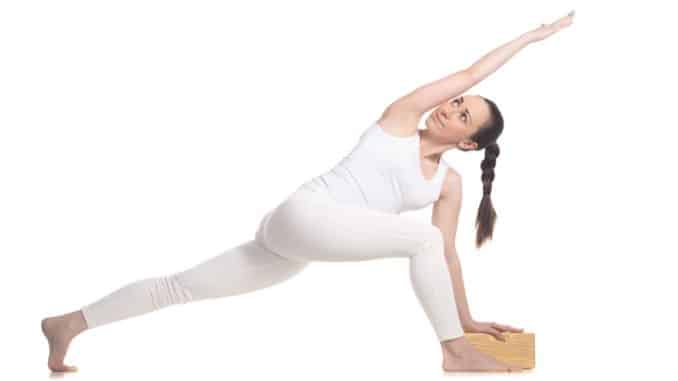
4. Double Pigeon Pose
With your knees bent, place a yoga block under your knees in Pigeon Pose to lessen the intensity and provide support, allowing for a comfortable stretch in the hips and glutes.
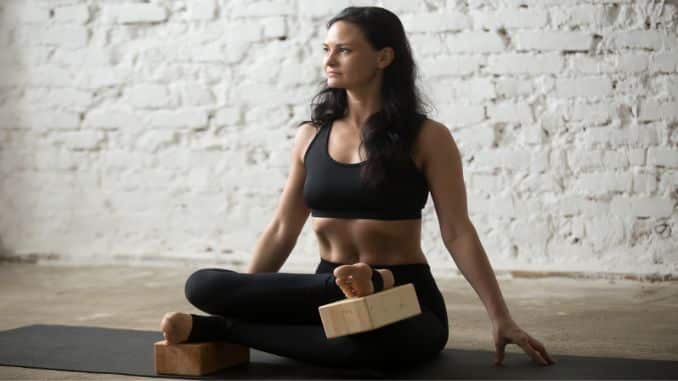
5. Standing Split
In a Standing Split, put a block under your foot for balance while working on flexibility.
6. Prayer Twist
Modify this classic yoga pose by squeezing a block between your palms while holding the Prayer Twist.
7. Boat Pose
A great modification of the traditional Boat Pose is to place a block between your inner thighs and press into it to engage your muscles more effectively.
8. Pyramid Pose
By placing a yoga block under your hands, you can bring the ground closer to you, making it easier to maintain a straight spine and square hips in Pyramid Pose.

9. Handstand Prep
Place a block against a wall and use it as a supportive foundation for your hands so you can practice kicking up into a controlled handstand position.
10. High to Low Plank Pose
This is a variation of the challenging transition from High to Low Plank that utilizes a block to provide additional stability.


B. Advanced Yoga Poses
1. Camel Pose Variation
Position a yoga block vertically between your shoulder blades as you lean back into Camel Pose.
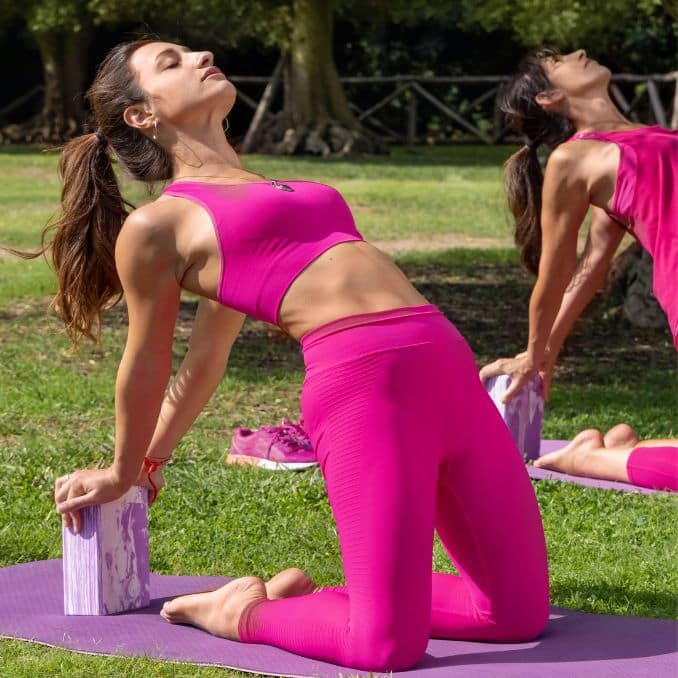
2. Firefly Pose
Begin in a squat position and place two blocks in front of you, resting your palms on the block as you shift your weight and lift your seat and feet off the ground, engaging the core and arm strength.
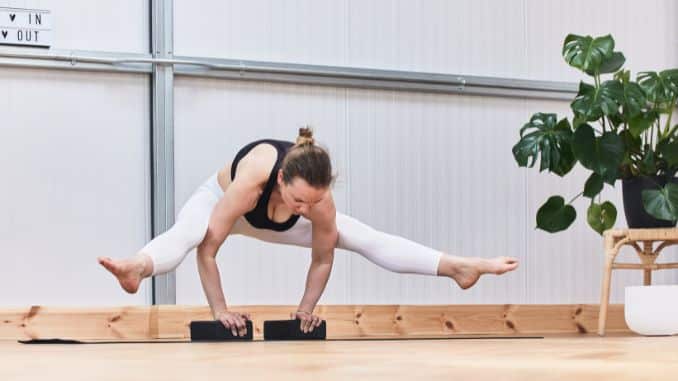
3. Wheel Pose
By placing a yoga block under your hands or between your shoulder blades, you can add an extra challenge to this pose and further open your front body.
4. Eight-Angle Pose
A block helps create a stable foundation while in an Eight Angle Pose.
5. Quad Stretch
Adding a block to a Supported Quad Stretch allows a deeper stretch while maintaining good alignment.
6. Russian Twists
This pose is a variation of the core-strengthening exercise that incorporates the use of a block by pressing it with both palms for added challenge and stability.
7. Side Plank
An advanced variation of this pose is the Side Plank Thread which increases stability.
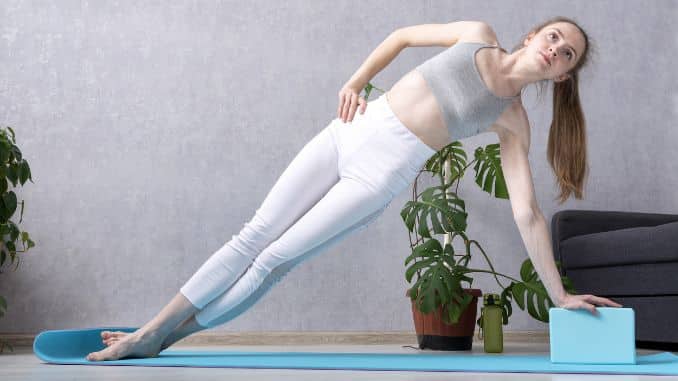
8. L Sit Arm Balance
By incorporating a block, this pose will strengthen the arms and improve balance.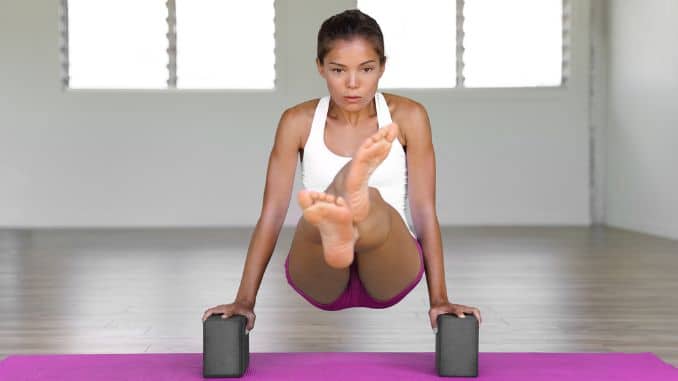
9. Lizard Pose
A modified version of this pose enhances a deeper stretch and provides support.

10. Crow Pose
The yoga block offers added support, making Crow Pose more effective in building arm and core strength.
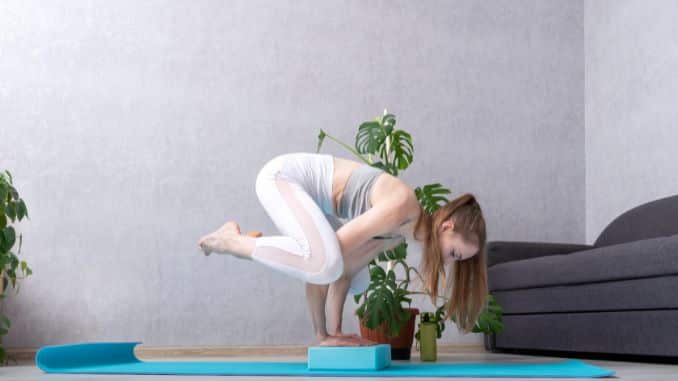
Yoga can be challenging, especially when it comes to mastering certain poses. However, using a yoga block can make the process easier and more accessible.
FAQs
What are the best yoga blocks for beginners?
The best yoga blocks for beginners are either cork or foam yoga blocks, depending on your needs. It’s important to choose a yoga block that feels comfortable and supportive to your body during practice.
How many yoga blocks do I need?
The number of yoga blocks you need depends on your personal preference and the type of yoga poses you practice. However, if you’re a beginner or have limited flexibility, you may need more blocks to support your body as you learn the poses.
Additionally, if you’re practicing a gentle yoga style or a restorative pose, you may want to have more blocks on hand to help you relax into the poses.
Conclusion: Building Flexibility with 15-Minute Yoga Block Poses for Beginners
Practicing yoga block poses is an excellent way to build flexibility and improve overall physical health. These poses are easy to perform and can be completed in as little as 15 minutes, making them a convenient addition to any daily routine.
Beginners can use yoga blocks to help achieve proper form, reducing the risk of injury and allowing for deeper stretches. Incorporating these poses into your practice can lead to increased flexibility, reduced stress, and improved posture.
Whether you’re just starting out or have been practicing yoga for years, adding yoga block poses to your routine can help take your practice to the next level.

